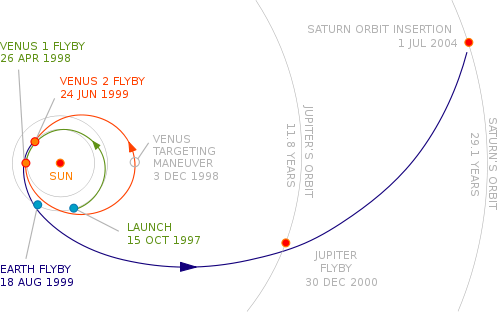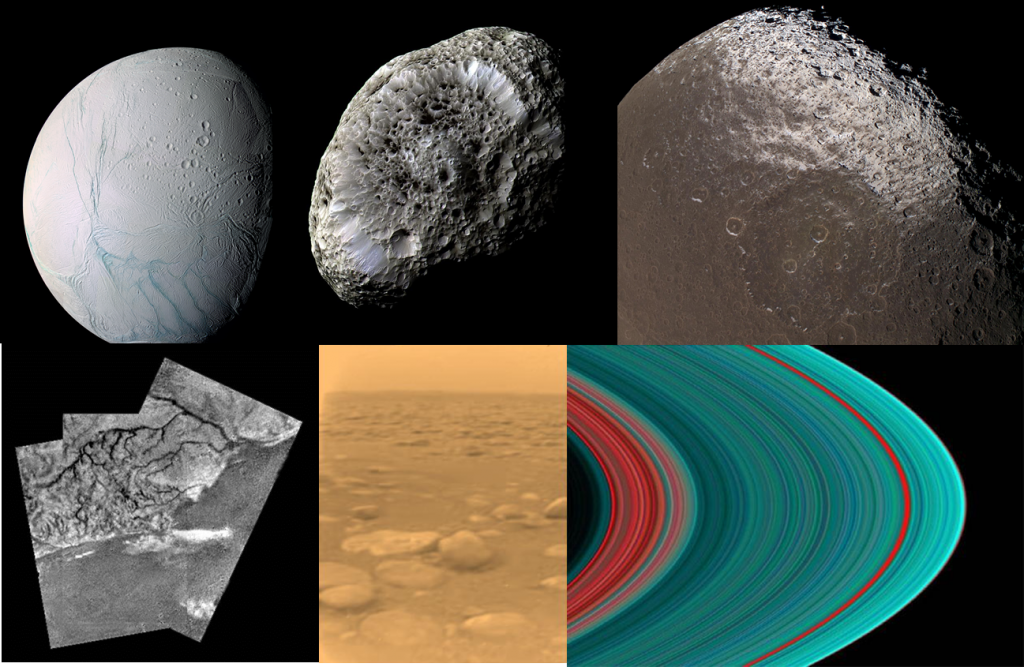What has compelled us to return to Saturn after the voyages of the robotic spacecraft, Pioneer and Voyager, in the latter part of the 20th century? Yes, Saturn with its rings was mysteriously beautiful. Like Jupiter it was a miniature Solar System with many moons of which Titan, the largest, appeared as an orange-shrouded mystery with a passing resemblance to a primordial Earth. Was it the outward urge or the pure science that led to Cassini, the robotic spacecraft that to this day continues to unravel Saturn’s mysteries and beauty?
For whatever the reason the voyage of the joint mission of Cassini and its companion Titan probe, Huygens, continues to amaze us with imagery and telemetry on the Saturnian system. NASA, the European Space Agency and the Italian Space Agency developed the technology that was launched in October of 1997. Seven years later the spacecraft arrived at Saturn entering into orbit around the planet. In 2005 the Huygens probe landed on Titan’s surface. Huygens transmitted images and data from the surface for a short period before falling silent. In its descent and landing we gained a great deal of knowledge about Titan.
Today Cassini continues to operate its cameras, spectrometers, magnetometers and analyzers as it swings around the planet visiting the moons and giving us spectacular images of the entire system including Saturn’s amazing rings.
The Challenge of Getting to Saturn
The technique deployed by Cassini to get to Saturn involved gravity assisted acceleration. In the diagram below you can see the indirect route taken. It involved a Venus flyby in 1998 and then Venus, a second time, followed by Earth in 1999. Next was a close encounter with Jupiter in 2000 and from there it travelled to Saturn arriving in 2004. Each planetary flyby provided a gravity assist to Cassini gaining speed with each pass. Total flight distance equalled 3.5 billion kilometers. This method allowed Cassini to save fuel and made it possible to keep its launch weight under six metric tons. Without gravity assist the spacecraft would have required a much larger compliment of fuel.

Designing a Spacecraft for Long Distance Communication and Survival
Cassini had to be designed to operate with a high degree of autonomy. On average it takes one hour and 24 minutes for a transmission from Earth to reach it. That means a 3-hour round trip between Earth and Saturn. The images Cassini transmits back to Earth give scientists a visual means of understanding the orientation of the spacecraft and its location within the Saturnian system. Instructions are then sent from Earth to orient the spacecraft’s instruments for whatever the planned objective whether a moon, the rings or the planet itself.
With the Cassini mission planned to continue for another five years until 2017, power and fuel consumption are paramount concerns. Cassini relies on three plutonium fuelled RTGs for power and heat in the extreme cold near Saturn. As the plutonium decays Cassini slowly loses power. But it has sufficient capacity to keeps its instrumentation in operation for the foreseeable future.
Propellants are another matter. Cassini is fuelled with two types of propellants, a mono-propellant and a bi-propellant. The mono-propellant, hydrazine, is used to do small maneuvers such as positioning and alignment. The bi-propellant, a mono-methyl hydrazine with nitrogen tetroxide has been used for course correction and other large maneuvers. When Cassini started out it had 132 kilograms of hydrazine, 1,131 kilograms of mono-methyl hydrazine and 1,869 kilograms of nitrogen tetroxide on board. Much of the fuel was spent getting to Saturn and for orbital insertion. The remainder is seldom used and as a result the spacecraft even with less than 10% of its original bi-propellant remaining can continue to fly.
What We Have Learned So Far About Saturn and its Moons
How do you sum up what we have learned from Cassini? The science and discoveries have been incredible. Here are some highlights:
- Saturn exhibits two vortexes at its poles with heat from the planet’s interior welling up into monstrous thunderstorms with powerful lightning bolts. The planet’s magnetic field interacts with the atmosphere at the poles to create extensive aurora similar to those on Earth. Its atmosphere is mostly hydrogen and helium but also contains traces of ammonia, phosphine, methane and other clouds. It rains and snows on Saturn. The planet’s core (about 6,000 kilometers, 3,700 miles in diameter) appears to consist of rock and ice reaching a temperature of between 10,000 and 15,000 Celsius (18,000 to 27,000 Fahrenheit) with layers of metallic and liquid hydrogen above. The separation between the liquid and gaseous hydrogen appears undefined.
- Saturn’s most obvious feature is its rings. Cassini has given us data on the ring structure and discovered new rings and ringlets, as well as moons near and in between rings with some of them stealing ring particles, and others losing particles to add to the rings.
- The Huygens probe and Cassini have given us a picture of Titan that is both alien and familiar. Titan has rivers and lakes. Its atmosphere has clouds that produce rain. Atmospheric pressure is just slightly higher than that found on Earth. Winds sculpt the landscape with vast dune fields constantly undergoing erosion. Volcanoes erupt as well just like on Earth. But unlike Earth where water forms a liquid, on Titan with its surface temperatures of -179 degrees Celsius (-290 Fahrenheit), it is methane that fills its rivers and lakes, forms the clouds and rains down from the skies. And the volcanoes spew ice rather than lava while its dunes consist of sand-like hydrocarbon particles. Titan’s interior includes an ocean of liquid water and ammonia with volcanic out-gassing constantly replenishing its atmosphere.
- Cassini has doubled the number of discovered Saturnian moons with 62 the latest count. Before it arrived at Saturn we knew of 31 from Pioneer, Voyager and Earth-based observations. Moon discoveries other than Titan include:
- a dynamic Enceladus that is geologically active with the discovery of simple organic compounds on its surface and liquid water beneath its frozen surface, making it very similar to Europa, one of Jupiter’s moons.
- the amazing bipolar nature of Iapetus with its enormous ridge dividing the planet into a dark and bright side
- the faint rings that surround Rhea
- the sponge-like nature of Hyperion’s surface where material impacts punch into the porous surface and ejecta escapes the moon’s low gravity
- the tiny moon, Aegaeon, one-half kilometer in diameter and orbiting within a segment of one of Saturn’s rings with debris from it contributing to the ring’s formation
With Cassini, we are not done yet but once the mission is over expect a return to Saturn’s neighbourhood with missions that will land and explore Titan and Enceladus.








